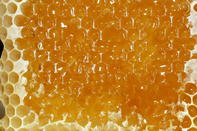Honey is the sweet thick liquid made, by honeybees and other insects, from the nectar of plants and can be found in various forms - from runny or creamed in texture to almost clear and dark brown in colour, with or without pieces of honeycomb.

There are various honey products in Cape Town and throughout South Africa to buy, as well as raw honey suppliers.
Dating back at least 4 000 years to hieroglyphs in Egypt showing the bee’s life, honey has been the only sweetener known to man for millennia. Interest in beekeeping started in 1792 after a book about bees and honey was written by Francois Huber, a blind naturalist and in the 1850’s American preacher Lorenzo Langstroth developed the first movable beehive, a patent that is still used today.
Standards of Honey in South Africa
Current South African legislation, the Agricultural Product Standards Act, 1990 (Act No. 119 of 1990) stipulates two grades - choice grade and industrial grade - for liquid honey, creamed honey and comb honey.
Legislation governs the quality by setting the levels of certain characteristics such as the honey’s fructose to glucose ratio, density and HMF (hydroxymethylfurfural present in honey and indicator of honey quality) content.
The Colour and Flavour of Honey
The quality of honey has nothing to do with its colour. The colour of honey depends on the source of the nectar and can range from water white to dark brown or almost black. For example, light coloured honey may originate from citrus blossoms, while dark amber-coloured honey may have been manufactured from the nectar of avocado blossoms or wildflowers.
The US-based National Honey Board explains that, similarly, the taste and flavour of honey also depend on the source of nectar. Avocado honey will have a rich buttery taste while honey produced from Eucalyptus species may show a variety of taste profiles, but often have a strong flavour with a slight medicinal taste. Contrasting this, honey made from citrus blossoms have a mild taste with a slight citrusy undertone.
Blueberry honey is light amber in colour with a well-rounded flavour. Acacia honey is mild and very sweet with a low sucrose content while honey from lucerne is less sweet than most other kinds of honey. Honey made from canola flower nectar granulates very quickly, often even in the hive.
Types of Honey in South Africa
Raw honey has not been heated, processed or pasteurised and is well suited to new beekeepers, as it does not require expensive heating and filtering equipment. It also contains bee pollen, which is high in amino acids and other beneficial ingredients. Raw honey can, however, become cloudy, ferment and granulated (crystallise).
The production thereof is a slower process and may contain bacteria. Commercial or regular honey may have been pasteurised. Pasteurisation is the killing of bacteria by heating a food product to 70℃ and then rapidly cooling it.
Heating honey makes it easier to filter and bottle and produces a clearer honey, which will not crystallise. ‘Creamed honey’ is finely crystallised honey, processed to have a uniform creamy consistency with a smooth spreadable texture.
‘Cut comb honey’ means honeycomb with honey, which has been cut and packed. ‘Honeydew honey’ means any dextrorotatory honey. This means that the honey is made from the sugary secretions of plant parts other than flowers, but can also mean that honey has been adulterated (mixed with syrup and other sugars) as the sugar molecules in ‘fake honey’ are different from that of pure honey.
Mānuka honey is made from the nectar of the flower of the Mānuka bush (Leptospermum scoparium), a plant indigenous to New Zealand. Mānuka honey is considered superior and has special antibacterial and wound-care properties.
Drinks with Honey
Honey is sweeter than sugar and can be used as an alternative to sugar in cocktails, iced teas, hot drinks and fruit-based drinks. Honey should be mixed with water - using equal parts (same volume) of each. Heat the mixture slightly until the honey dissolves into the water. The mix can be stored for about two weeks.
The Scottish drink Drambuie is a liqueur made with whiskey, honey, spices and herbs, while mead is a fermented mix of honey, yeast and water. The origins of mead can be dated back to Chinese pottery vessels from 7000 B.C. Herb and spice-infused mead is believed to cure depression and improve digestion.
What is Fake Honey?
In 2018, it was found that fake honey was sold in South Africa. This fake honey could have been produced locally, although most of South Africa’s honey is imported from China. Local producer, Peel’s Honey, explains that fake honey is made by mixing real honey with corn syrup, sugar cane or rice sugar.
This process is called “adulteration”. Adding sugar syrups or even water to real honey allows producers to sell this fake honey at lower prices than pure honey. (‘Real’ honey traded for around R65/500g in 2018).
The issue with fake honey is two-fold: health and economics. Fake honey with added sugar can impact negatively on the health (and blood sugar levels) of consumers, especially diabetics.
Secondly, the lower price of fake honey makes it difficult for local beekeepers to compete. Consumers are advised to read the labels carefully. To buy local South African honey look for the words ‘produced in South Africa’ as opposed to ‘packaged in South Africa’.
A simple home test: mix equal parts honey and methylated spirits. Real (pure) honey will sink to the bottom, while fake honey will mix with the spirits.
By Marinda Louw